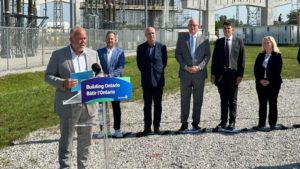 July 18, 2023 (updated from July 10); Version published in the Toronto Star July 15/July 21, 2023.
July 18, 2023 (updated from July 10); Version published in the Toronto Star July 15/July 21, 2023.
Ontario’s energy plan released last week opened the door marginally on renewable energy and energy efficiency. But it also reaffirmed the centrality of nuclear energy to the province’s plans. In fact, the announcements by the Ford government of a 4800MW in new build nuclear projects at the Bruce Nuclear site near Tiverton, and three additional new reactors at the Darlington site east of Toronto, committed Ontario to one of the largest nuclear construction programs in the world.
The consequences of these decisions for Ontario electricity ratepayers and taxpayers are likely to stretch far into the future. No cost estimates are available for the proposed nuclear projects. The bids submitted as part of the province’s last attempt at a new-build nuclear project would optimistically suggest costs in the range of $50 billion for the Bruce project alone. The costs of the four smaller reactors proposed for Darlington remain essentially unknown, given that none of the proposed type of reactor have ever been built or operated before anywhere in the world, but will run into the billions as well.
The challenges around nuclear energy are well known. A long and ongoing history of massive cost overruns and construction delays; waste fuel that will require management on a timescale of a million years; and accident, security and weapons proliferation risks that simply don’t exist in relation to other energy technologies.
These points were again highlighted in the same week as Ontario’s announcements by the International Atomic Energy Agency’s approval of the discharge of more than one million tonnes of contaminated water from the 2011 Fukushima nuclear disaster into the Pacific Ocean, and the continuing news of fighting around the Zaporizhzhia nuclear plant in Ukraine.
Nuclear has not experienced the kinds of cost reductions (Figure SPM3) seen with other energy technologies, such as renewables and energy storage, as experience with their production and use has grown. Its long and complicated development and construction timelines, even under the best of circumstances, make it a marginal contributor (Figure SPM.7) to any significant GHG emission reductions by 2030, particularly relative to wind and solar, and forest and ecosystem conservation and restoration. Its longer-term prospects as a climate mitigation strategy look doubtful for the same reasons.
Given these risks, private capital has been hesitant to engage with nuclear projects, and progress on a much-touted nuclear ‘renaissance’ in Europe and North America has been slow. This has been despite aggressive efforts by governments to guarantee returns on investment and assume ultimate liability for waste management, decommissioning costs and accidents. It is no surprise that the only significant investor in the first of the proposed new ‘small’ reactors at Darlington was the federal government’s own Infrastructure Bank.
A rational planning process around electricity and decarbonization would have prioritized the options with the lowest economic, environmental, technological and safety risks first. Higher-risk options, like new nuclear, should only be considered where it can be demonstrated that the lower-risk options have been fully optimized and developed in the planning process.
This would suggest maximizing demand-side measures to increase energy efficiency and productivity and reduce energy demand. Development of low-impact and risk energy sources with relatively short planning and construction timelines like wind, solar, and the optimization of existing hydro resources, along with advanced energy storage technologies, should follow. Relationships around existing out-of-province (e.g. Quebec) hydro and new low-impact renewable resources would be strengthened.
Unfortunately, the province has chosen to take precisely the opposite path – pursuing the highest cost, highest risk and highest negative impact option – nuclear expansion – first, along with growth in greenhouse gas-intensive natural gas-fired generation. Everything else - efficiency, renewables, and distributed energy resources – has been left to the margins, with no specific targets or objectives. The situation is further complicated by the lack of any substantive overall commitment or strategy for decarbonization on the part of the province, particularly in key areas like transportation, land-use and space heating.
In many ways, Ontario was an ideal candidate for nuclear proponents. It has no meaningful planning process around its electricity system – the process is instead governed by political directives. That means there is no need to explain or justify costs and risks flowing from its nuclear-heavy plan, or consider alternative pathways to decarbonization, before any sort of meaningful public review process or regulatory body.
Moreover, the province is led by a government that is fond of being seen to be building megaprojects, and for which long-term critical thinking is generally not regarded as an area of great strength. It had refused to consider renewable energy development regardless of what cost or other advantages it might offer, and repeatedly rejected overtures for Quebec around its hydro and renewable resources. It previously dismantled a relatively successful strategy around energy efficiency.
The good news is that the province’s announcements remain at a preliminary stage – key technical approvals for new build reactor projects will still be needed and their economics remain very open questions. There may still be time for Ontario to move towards a more rational, open, and evidence-based approach to energy planning and decarbonization. But nuclear proponents will be doing everything they can to lock in the government’s choices as quickly as possible.
